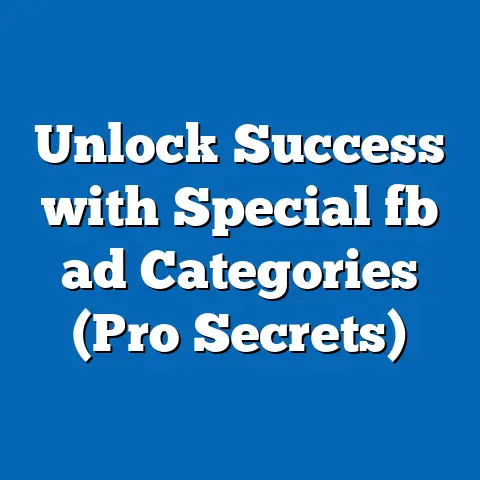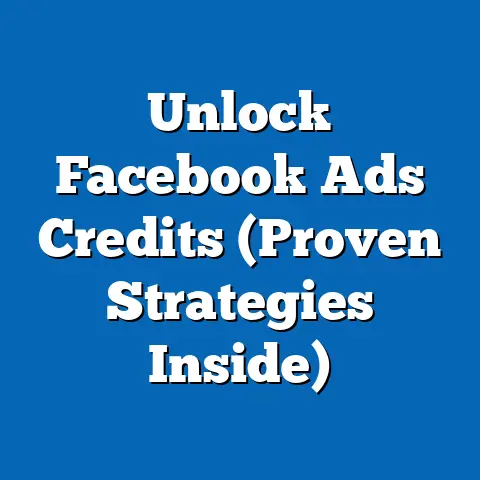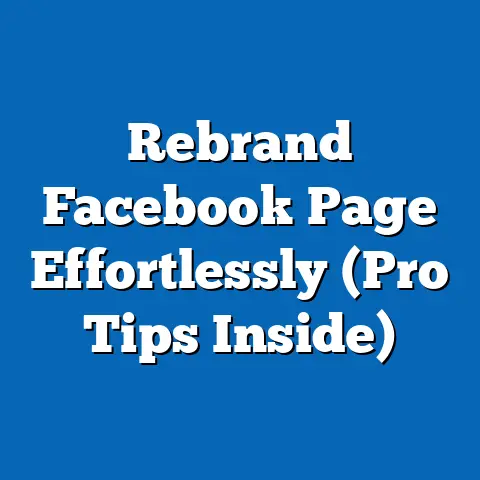Boost Book Sales on Facebook (Proven Strategies)
Books have always held a special place in my heart. Growing up, evenings were often spent huddled together as a family, lost in the worlds woven by words. My grandfather, a retired history professor, would regale us with tales of ancient civilizations, while my mother, a passionate English teacher, introduced us to the magic of classic literature. These moments weren’t just about reading; they were about connection, about sharing experiences and building a foundation of love and learning.
This personal experience has shaped my understanding of the power of books and the importance of fostering a reading culture within families. And that’s why I’m so passionate about helping authors and publishers connect with families on Facebook. In today’s digital age, Facebook offers an incredible opportunity to reach a vast and engaged audience, creating a community of readers who share their love for books. But to succeed, it’s crucial to understand your target audience – especially families – and craft Facebook ads that resonate with their values and aspirations.
In this guide, I’ll walk you through proven strategies for boosting book sales on Facebook, focusing on how to effectively reach and engage families. From understanding your audience to crafting compelling ad content and leveraging Facebook groups, I’ll provide actionable tips and insights to help you connect with the right readers and drive sales.
Section 1: Understanding Your Audience
Before diving into ad creation and targeting, it’s essential to deeply understand your audience. When it comes to book sales on Facebook, families represent a significant and valuable segment. But “family” is a broad term, so let’s break it down.
Defining the Family Audience
When targeting families, consider these key demographic insights:
- Age Groups: Parents typically fall within the 25-55 age range, while children span from toddlers to teenagers. Understanding the age range of your book’s target audience is crucial. Are you selling board books for toddlers, chapter books for middle graders, or young adult novels?
- Interests: Family interests are diverse, ranging from parenting tips and educational resources to family travel, cooking, and entertainment. Think about the specific interests that align with your book’s theme and target audience. For example, if you’re selling a children’s book about animals, targeting interests like “zoos,” “wildlife,” and “nature” would be beneficial.
- Reading Habits: Consider the types of books families typically enjoy. Do they prefer picture books, chapter books, fantasy novels, or non-fiction educational books? Understanding their reading preferences will help you tailor your ad content and messaging.
The Importance of Family Dynamics
Understanding family dynamics is crucial for crafting effective Facebook ads. Consider these key factors:
- Parents as Gatekeepers: Parents often make the purchasing decisions for children’s books. Therefore, your ads should appeal to their values, concerns, and aspirations for their children. Highlight the educational value, entertainment quality, and positive messages conveyed by your book.
- Family-Oriented Themes: Books that explore family relationships, promote positive values, or offer opportunities for shared experiences resonate strongly with families. Emphasize these themes in your ad copy and visuals.
- Emotional Connection: Reading together as a family creates lasting memories and strengthens bonds. Tap into these emotions by showcasing heartwarming images and stories of families enjoying your book.
Leveraging Facebook Audience Insights
Facebook Audience Insights is a powerful tool for gaining a deeper understanding of your target audience. By analyzing demographic data, interests, and behaviors, you can uncover valuable insights that inform your ad strategy.
For example, you can use Audience Insights to identify the most popular Facebook pages and groups among parents, the types of content they engage with, and the products they purchase. This information can help you refine your targeting and create ads that resonate with their specific needs and interests.
Takeaway: Spend time researching your target audience and understanding their needs, interests, and values. This knowledge will be invaluable in crafting effective Facebook ads that resonate with families and drive book sales.
Section 2: Crafting Engaging Ad Content
Once you understand your audience, it’s time to craft ad content that captures their attention and compels them to take action.
The Power of Storytelling
Storytelling is a powerful tool for connecting with families on an emotional level. Instead of simply listing the features of your book, tell a story that highlights its unique value and resonates with their experiences.
For example, if you’re selling a children’s book about overcoming fears, you could share a story about a child who learns to be brave with the help of the book’s characters. Or, if you’re selling a cookbook with family-friendly recipes, you could share a story about a family who creates lasting memories by cooking together.
Visually Appealing Graphics
Visuals play a crucial role in capturing attention on Facebook. Use high-quality images and videos that showcase family reading moments and evoke positive emotions.
Here are some tips for creating visually appealing graphics:
- Showcase Families Reading Together: Use images of families reading your book together, highlighting the joy and connection it brings.
- Highlight the Book’s Cover: Ensure your book’s cover is prominently displayed in your ad.
- Use Bright and Cheerful Colors: Choose colors that are visually appealing and evoke positive emotions.
- Create Short and Engaging Videos: Use short videos to showcase the book’s illustrations, characters, and story.
Compelling Ad Copy
Your ad copy should be clear, concise, and persuasive. Use language that resonates with families and highlights the benefits of reading your book.
Here are some tips for writing compelling ad copy:
- Focus on Benefits, Not Features: Instead of simply listing the features of your book, focus on the benefits it offers to families. For example, instead of saying “This book has 20 colorful illustrations,” say “This book will spark your child’s imagination with 20 vibrant and captivating illustrations.”
- Use Emotional Language: Tap into the emotions of parents by highlighting the joy, connection, and learning that reading can bring.
- Include a Clear Call-to-Action: Tell readers exactly what you want them to do, whether it’s “Buy Now,” “Learn More,” or “Download a Free Chapter.”
Testimonials and Quotes
Include testimonials or quotes from families who have enjoyed your book. This social proof can significantly enhance your credibility and influence purchasing decisions.
You can gather testimonials by reaching out to readers who have left positive reviews on Amazon or Goodreads. You can also ask for testimonials from parents who have read your book to their children.
Takeaway: Craft ad content that tells a compelling story, showcases visually appealing graphics, and uses persuasive language. Incorporate testimonials and quotes to build trust and credibility.
Section 3: Targeting Techniques on Facebook
Facebook’s robust targeting options allow you to reach specific audiences based on their demographics, interests, and behaviors. When targeting families, it’s crucial to utilize these options effectively to reach the right readers.
Demographic Targeting
Use demographic targeting to reach parents within specific age ranges, locations, and education levels. For example, you can target parents aged 25-45 who live in the United States and have a college degree.
Interest Targeting
Use interest targeting to reach parents who are interested in specific topics related to family, reading, and education. Some relevant interests include:
- Parenting
- Children’s Books
- Education
- Family Activities
- Reading
- Homeschooling
Behavioral Targeting
Use behavioral targeting to reach parents who have exhibited specific behaviors on Facebook, such as:
- Purchasing children’s products
- Engaging with parenting-related content
- Joining parenting groups
Custom Audiences and Lookalike Audiences
Custom Audiences allow you to target specific groups of people based on your existing customer data. For example, you can upload a list of email addresses from your newsletter subscribers and create a Custom Audience of those individuals.
Lookalike Audiences allow you to find new people who are similar to your existing customers. By creating a Lookalike Audience based on your Custom Audience, you can reach potential readers who share similar demographics, interests, and behaviors with your current audience.
Retargeting Ads
Retargeting ads allow you to reach users who have previously engaged with your content, such as visiting your website or watching your videos. This is a highly effective strategy for driving conversions, as you’re targeting individuals who have already expressed interest in your book.
Takeaway: Utilize Facebook’s diverse targeting options to reach families who are most likely to be interested in your book. Experiment with different targeting combinations to find what works best for your audience.
Section 4: Utilizing Facebook Groups and Communities
Facebook Groups offer a valuable opportunity to connect with niche communities and engage with potential readers organically.
Joining Relevant Groups
Search for Facebook Groups related to parenting, reading, and education. Join these groups and actively participate in discussions, offering helpful advice and sharing relevant content.
Promoting Your Book Organically
While it’s important to avoid blatant self-promotion, you can subtly promote your book by sharing excerpts, behind-the-scenes stories, and relevant articles.
For example, if you’re selling a children’s book about environmental conservation, you could share an article about a local park cleanup and mention how your book encourages children to care for the environment.
Creating Your Own Group
Consider creating a dedicated Facebook Group for book lovers to share reviews, recommendations, and family reading experiences. This can be a great way to build a community around your book and foster a loyal following.
Collaborating with Group Admins
Reach out to group admins and offer to collaborate on promotional events or book discussions. This can be a mutually beneficial partnership that helps you reach a wider audience and provides valuable content to the group members.
Takeaway: Leverage Facebook Groups to connect with niche communities, engage with potential readers, and promote your book organically.
Section 5: Running Effective Promotions and Contests
Promotions and contests are a great way to boost engagement, generate excitement, and drive book sales.
Family-Oriented Contests
Create contests that are specifically designed to appeal to families. Some ideas include:
- Photo Competition: Ask families to submit photos of themselves reading your book together.
- Storytelling Contest: Ask children to write short stories based on your book’s characters or themes.
- Drawing Contest: Ask children to draw pictures inspired by your book.
Promoting Contests with Facebook Ads
Use Facebook Ads to promote your contests and drive traffic to your contest entry page. Target your ads to families who are interested in reading, education, and family activities.
Clear Call-to-Actions
Ensure your ads and posts related to promotions have clear call-to-actions. Tell readers exactly what you want them to do, whether it’s “Enter the Contest,” “Learn More,” or “Buy Now.”
Takeaway: Run family-oriented contests and promotions to boost engagement and drive book sales. Promote these events with Facebook Ads and ensure clear call-to-actions.
Section 6: Measuring Success and Ad Optimization
Tracking your ad performance is crucial for understanding what’s working and what’s not. By analyzing key metrics, you can optimize your ads for better results.
Key Metrics to Track
Here are some key metrics to track for Facebook ads focused on book sales:
- Reach: The number of people who saw your ad.
- Impressions: The number of times your ad was displayed.
- Engagement Rate: The percentage of people who engaged with your ad (e.g., liked, commented, shared).
- Click-Through Rate (CTR): The percentage of people who clicked on your ad.
- Conversion Rate: The percentage of people who completed a desired action (e.g., purchased your book) after clicking on your ad.
- Cost Per Click (CPC): The average cost you paid for each click on your ad.
- Cost Per Conversion (CPC): The average cost you paid for each conversion (e.g., book sale).
Analyzing Ad Performance
Analyze your ad performance data to identify trends and patterns. Which ads are generating the most engagement? Which targeting options are yielding the highest conversion rates?
A/B Testing
A/B testing involves testing different versions of your ads to see which performs best. For example, you can test different headlines, images, or call-to-actions.
Data-Driven Decisions
Make data-driven decisions to optimize your ads for better performance. If an ad isn’t performing well, try changing the headline, image, or targeting options. Continuously monitor your ad performance and make adjustments as needed.
Takeaway: Track your ad performance, analyze the data, and make data-driven decisions to optimize your ads for better results.
Conclusion
Facebook offers a powerful platform for boosting book sales, particularly among families. By understanding your audience, crafting engaging ad content, utilizing targeted advertising techniques, leveraging Facebook Groups, running effective promotions, and measuring your success, you can connect with the right readers and drive sales.
Remember, building a community of readers who cherish family time together through books is the ultimate goal. With the right approach, authors and publishers can successfully connect with families and foster a love for reading that translates into increased sales. So, embrace these strategies, experiment with different approaches, and watch your book sales soar!






